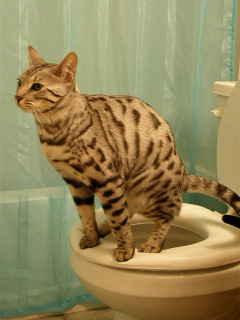Prevent Bathroom Emergencies: Don't Flush Cat Poop Down Your Toilet - Expert Guidance
Prevent Bathroom Emergencies: Don't Flush Cat Poop Down Your Toilet - Expert Guidance
Blog Article
Listed here below you can get some great facts with regards to Don’t flush cat feces down the toilet.

Introduction
As cat owners, it's vital to be mindful of just how we throw away our feline good friends' waste. While it may seem convenient to flush pet cat poop down the commode, this technique can have harmful consequences for both the environment and human wellness.
Alternatives to Flushing
Luckily, there are safer and much more accountable means to get rid of pet cat poop. Think about the complying with alternatives:
1. Scoop and Dispose in Trash
One of the most common technique of getting rid of pet cat poop is to scoop it into an eco-friendly bag and toss it in the trash. Be sure to make use of a devoted clutter inside story and dispose of the waste quickly.
2. Usage Biodegradable Litter
Go with eco-friendly feline litter made from products such as corn or wheat. These clutters are eco-friendly and can be securely taken care of in the garbage.
3. Hide in the Yard
If you have a lawn, consider burying pet cat waste in an assigned area far from veggie yards and water resources. Make sure to dig deep adequate to stop contamination of groundwater.
4. Mount a Pet Waste Disposal System
Invest in a pet dog garbage disposal system specifically developed for cat waste. These systems make use of enzymes to break down the waste, minimizing odor and environmental effect.
Health and wellness Risks
In addition to environmental worries, flushing cat waste can likewise pose health risks to humans. Pet cat feces might have Toxoplasma gondii, a parasite that can trigger toxoplasmosis-- a potentially severe illness, particularly for expectant ladies and people with damaged immune systems.
Environmental Impact
Flushing cat poop presents harmful pathogens and parasites into the water, posing a substantial danger to marine communities. These impurities can negatively affect aquatic life and compromise water top quality.
Final thought
Responsible animal possession extends past offering food and shelter-- it likewise includes correct waste management. By refraining from purging cat poop down the bathroom and choosing different disposal techniques, we can minimize our ecological footprint and secure human health and wellness.
Why Can’t I Flush Cat Poop?
It Spreads a Parasite
Cats are frequently infected with a parasite called toxoplasma gondii. The parasite causes an infection called toxoplasmosis. It is usually harmless to cats. The parasite only uses cat poop as a host for its eggs. Otherwise, the cat’s immune system usually keeps the infection at low enough levels to maintain its own health. But it does not stop the develop of eggs. These eggs are tiny and surprisingly tough. They may survive for a year before they begin to grow. But that’s the problem.
Our wastewater system is not designed to deal with toxoplasmosis eggs. Instead, most eggs will flush from your toilet into sewers and wastewater management plants. After the sewage is treated for many other harmful things in it, it is typically released into local rivers, lakes, or oceans. Here, the toxoplasmosis eggs can find new hosts, including starfish, crabs, otters, and many other wildlife. For many, this is a significant risk to their health. Toxoplasmosis can also end up infecting water sources that are important for agriculture, which means our deer, pigs, and sheep can get infected too.
Is There Risk to Humans?
There can be a risk to human life from flushing cat poop down the toilet. If you do so, the parasites from your cat’s poop can end up in shellfish, game animals, or livestock. If this meat is then served raw or undercooked, the people who eat it can get sick.
In fact, according to the CDC, 40 million people in the United States are infected with toxoplasma gondii. They get it from exposure to infected seafood, or from some kind of cat poop contamination, like drinking from a stream that is contaminated or touching anything that has come into contact with cat poop. That includes just cleaning a cat litter box.
Most people who get infected with these parasites will not develop any symptoms. However, for pregnant women or for those with compromised immune systems, the parasite can cause severe health problems.
How to Handle Cat Poop
The best way to handle cat poop is actually to clean the box more often. The eggs that the parasite sheds will not become active until one to five days after the cat poops. That means that if you clean daily, you’re much less likely to come into direct contact with infectious eggs.
That said, always dispose of cat poop in the garbage and not down the toilet. Wash your hands before and after you clean the litter box, and bring the bag of poop right outside to your garbage bins.
https://trenchlesssolutionsusa.com/why-cant-i-flush-cat-poop/

As a keen reader on Can You Flush Cat Poo or Litter Down the Toilet?, I figured sharing that excerpt was a good idea. Please take a moment to share this blog entry if you enjoyed reading it. Thanks a lot for your time. Don't forget to check our blog back soon.
Here Report this page